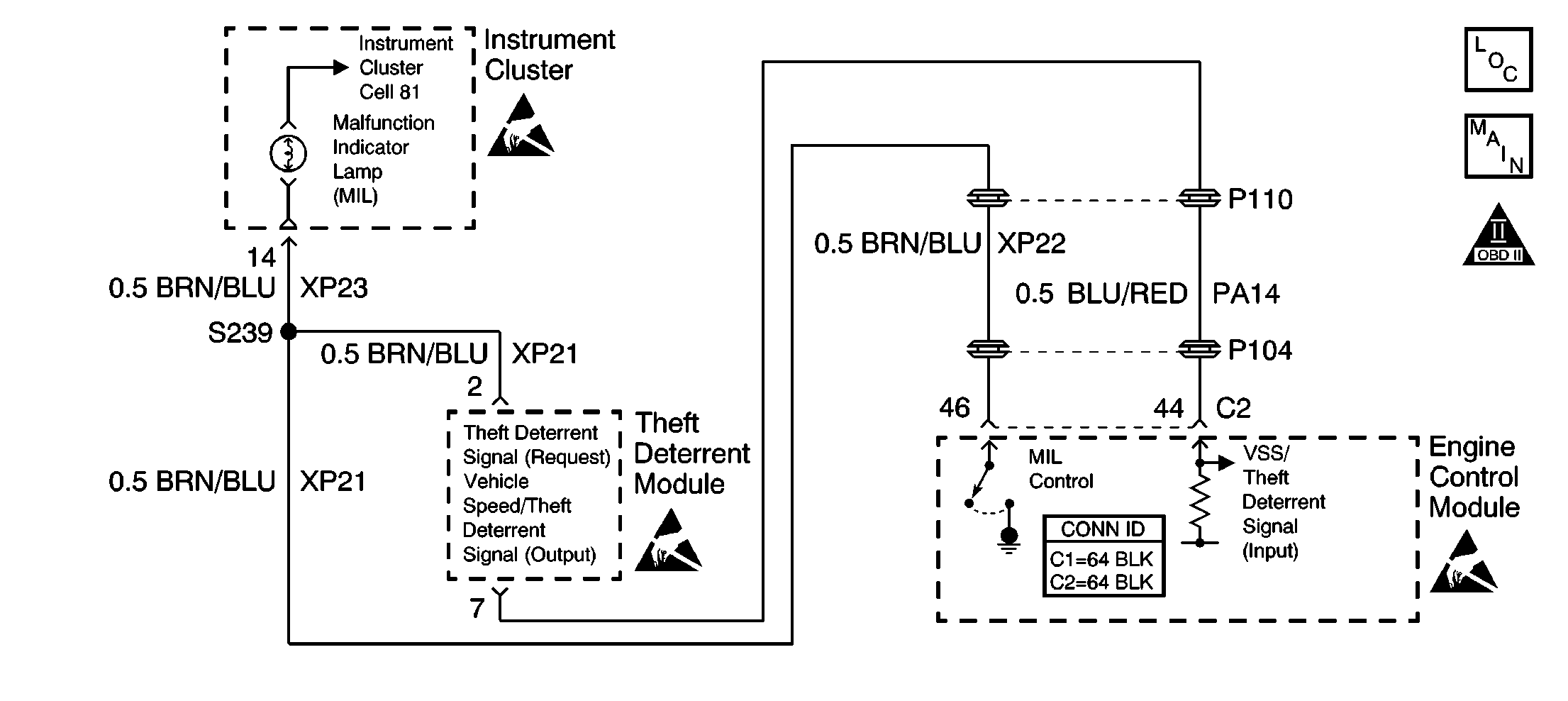
Circuit Description
A processed wheel speed sensor signal is sent from the anti-lock brake system electronic brake and traction control module (EBTCM) controller to the theft deterrent module. The signal is then sent from the theft deterrent module to the engine control module (ECM). The ECM calculates the vehicle speed from this signal. The vehicle speed/theft deterrent signal circuit is pulled up from B+ within the ECM. The circuit from the ABS controller to the theft deterrent module is covered by the ABS controller diagnostics.
Conditions for Running the DTC
| • | The fuel cut-off is enabled. |
| • | The engine speed is between 1800-2200 RPM. |
| • | The engine coolant temperature ECT is greater than 65°C (149°F). |
Conditions for Setting the DTC
The vehicle speed signal is less than 20 km/h (12 mph) for longer than 1 second.
Action Taken When the DTC Sets
The ECM turns on the malfunction indicator lamp (MIL) and records the operating conditions in the Freeze Frame on the second consecutive drive trip that the diagnostic runs and fails.
Conditions for Clearing the MIL/DTC
| • | The ECM turns off the MIL after three consecutive drive trips that the diagnostic runs and passes. |
| • | A History DTC clears after forty consecutive warm-up cycles in which no failures are reported by this diagnostic or any other emission related diagnostic. |
| • | The ECM battery voltage is interrupted. |
| • | The scan tool clears the MIL/DTC. |
Diagnostic Aids
Notice: Using the J 35616-A Connector Test Adapter Kit will prevent damage to the harness connector terminals.
Use the J 35616-A Connector Test Adapter Kit for any test that requires probing the ECM harness connector or a component harness connector.
Check for the following conditions:
| • | Poor connections at the ECM or at the component--Inspect the harness connectors for the following conditions: |
| - | Backed out terminals |
| - | Improper mating |
| - | Broken locks |
| - | Improperly formed or damaged terminals |
| - | Poor terminals to wire connections |
| - | Refer to Wiring Repairs in Wiring Systems for the proper procedures. |
| • | A misrouted harness--Make sure that the harness is not routed too close to any high voltage wires such as the spark plug leads, or high current devices such as the alternator, the motors, the solenoids, etc. |
| • | A damaged harness--Inspect the wiring harness for any damage. If the harness appears to be OK, observe the scan tool while moving the related connectors and the wiring harnesses. A change in the display may reveal the location of the fault. |
| If the sensor signal is only affected when the harness is moved at a component, and there is no problem with the harness or the connections, the component may be damaged. |
| Refer to Symptoms for assistance in diagnosing intermittent concerns. |
Test Description
The numbers below refer to the step numbers on the diagnostic table.
-
This step verifies that the fault is currently present.
-
The test lamp connected to B+ is used to simulate the B+ pull-up within the ECM. The DMM can be connected to the shaft of the test lamp and battery ground. The momentary frequency signal verifies the initial communication between the theft deterrent system and the ECM.
Step | Action | Values | Yes | No | ||||||
|---|---|---|---|---|---|---|---|---|---|---|
1 | Did you perform the Powertrain On-Board Diagnostic (OBD) System check? | -- | ||||||||
Notice for Vehicles With Independent Suspension: Notice: Support the lower control arms in the normal horizontal position in order to avoid damage to the drive axles. Do not operate the vehicle in gear with the wheels hanging down at full travel.
Does the scan tool indicate a vehicle speed above the specified value? | 0.0 mph/km/h | Go to Diagnostic Aids | ||||||||
Does the DMM momentarily indicate frequency within the specified range? | 100-900 Hz | |||||||||
4 |
Did you find a problem? | -- | ||||||||
5 |
Does scan tool indicate a speed above the specified value? | 0.0 km/h (0 mph) | Go to Diagnostic System Check - ABS in Antilock Brake System | |||||||
6 | Repair the vehicle speed/theft deterrent signal circuit between the theft deterrent module harness connector and the ECM. Is the action complete? | -- | -- | |||||||
7 | Check for poor connections/terminal tension at the theft deterrent module harness connector. Refer to Wiring Repairs in Wiring Systems. Also, refer to Checking Terminal Contact in Engine Control Module Diagnosis . Did you find and correct a problem? | -- | Go to Diagnostic System Check - Theft Deterrent in Theft Deterrent | |||||||
8 | Check for a poor connection or poor terminal tension at the ECM harness connector. Refer to Wiring Repairs in Wiring Systems. Also, refer to Checking Terminal Contact in Engine Control Module Diagnosis . Did you find and correct a problem? | -- | ||||||||
9 |
Important:
Replace the ECM. Refer to Engine Control Module Replacement/Programming . Is the action complete? | -- | -- | |||||||
10 |
Does the scan tool indicate that the diagnostic Passed? | -- | ||||||||
11 | Does the scan tool display any additional undiagnosed DTCs? | -- | Go to the applicable DTC table | System OK |
